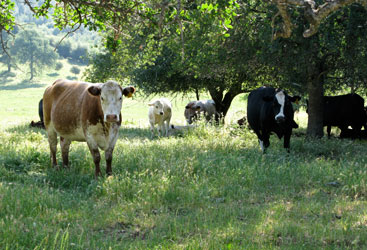Heat stress in cattle – Know the warning signs!
Cattle heat stress, Managing and reducing livestock heat stress
Recent summer temperatures combined with high dew points can cause significant heat stress to cattle. Heat stress is magnified with high temperatures overnight. The combination of high day and night time temperatures prevents cattle from cooling. Three days of these conditions can result in elevated heat stress levels. Here are some simple tips to make sure your cattle stay comfortable:

Avoid handling, transporting, moving, or processing cattle. If cattle must be handled, work in the early in the morning hours using low stress handling techniques.
Provide additional water. For cattle on pasture, provide additional water supply, especially if they only have access to one tank in the pastures. Check water sources frequently for problems and provide additional tank capacity as water intake increases.
Observe cattle for abnormal behavior. Problems often occur during stressful events. Watch cattle movement, location and behavior for indications of problems. Have a back-up plan ready if power or water systems fail.
Provide shade. During heat stress days, shade is critical especially for dark-haired, fleshy, young and older cattle. Shade can easily be provided by allowing access to pasture with trees or providing access to open buildings.
Provide adequate ventilation. If cattle are being fed and housed in an enclosed barn or building, use fans to move air out or through the building or open sides of the barn or provide access to an outside pen or pasture with shade. Using sprinklers in this situation will potentially intensify the problem and create more humidity without proper air movement to remove it from the building.
The first sign of heat stress is increased breathing followed by open mouth breathing (panting), and slobbering. As the heat stress becomes severe, cattle will tremble and lose coordination. If they go down, they most likely will not recover. When first signs of heat stress are observed, minimize the stress immediately with the tips above. Early intervention is the key to survival, especially providing intervention in the evening when cattle are trying to dissipate heat from day.
Also be aware that heat could have implications which may not be seen immediately. If you are in breeding season with your cow herd, heat stress could result in greater losses in the first few weeks after conception. For bulls preparing for breeding season, the high temperatures could impact semen quality 2 to 4+ weeks later, resulting in lower conception rates a month after the heat stress event. These are additional reasons to keep your cow herd cool during times of high heat index weather.
For more management resources, including heat stress prediction maps, are available online from the US Meat Animal Research Center.
For additional cattle management resources, visit the MSU Beef Team website.



 Print
Print Email
Email



